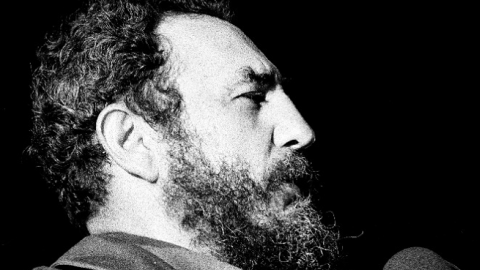Juan Reinaldo Sánchez was drafted into the Cuban Army in 1967 and assigned to the Department of Personal Security, the branch dedicated to protecting Fidel Castro. Starting at the lowest rung, where he was assigned to the blocks where Cuba’s top revolutionary leaders worked, Sánchez quickly rose through the ranks because of his good performance and revolutionary attitude. As a result, he was selected to join an elite group, made up of two divisions of 1,500 handpicked troops, who protected Fidel Castro 24 hours a day. Sánchez certainly stood out: In 1976, he graduated from a new training school for elite security agents where he earned a black belt in karate and became Cuba’s top sniper and best pistol shooter, a status gained from national military competitions.
Eventually chosen to be Castro’s main security guard, Sánchez accompanied Castro everywhere he went, including trips to the Soviet Union, Central and South America, and Western European capitals. As such, he was in the unique position to observe Castro and his actual lifestyle, one 180 degrees from the “socialist” values he preached and supposedly lived. In fact, according to Sánchez, Castro lives like a typical Latin American caudillo: He “transformed and enlarged his father’s [large plantation] property to make Cuba into a single hacienda of eleven million people” in which, as lord and master, he would control the lives of his subjects, virtually the entire Cuban population of poor peasants and urban dwellers.
Fidel Castro has often told Cubans and the world press that he is an exemplary revolutionary leader who works day and night for the revolution and lives as simply as the poorest Cuban, taking only a meager official salary of $38 per month (in American dollars). Sánchez finds this myth “highly comic,” since, in reality, Castro was the CEO of what might be called Cuba Holdings, an entity with sums in the millions, all of it available for Castro’s personal use at a moment’s whim.
Sánchez details how Castro uses this wealth for his personal comfort, a state secret carefully hidden from the people he led until his recent official retirement. For the first time, Sánchez exposes the secret properties Castro owns, giving exact locations, using maps and Google satellite imagery. The leader who preaches the need to sacrifice for the revolution has, in addition to 20 homes throughout the island, a private island called Cayo Piedra, where he and his entourage would go each weekend in June and for the entire month of August. It was, writes Sánchez, a “millionaire’s paradise” where Castro kept his private yacht, Aquarama II, and had his own ecological underwater sanctuary.
Despite Castro having an official photographer, Sánchez notes that no photos were ever allowed to be taken of his vacation paradise. Few, except his immediate family—his wife Dalia and their five children—were allowed to go there. There were a few exceptions, including the explorer Jacques Cousteau; news people such as Barbara Walters of ABC and Ted Turner, whose favorable coverage on CNN Castro appreciated; and Erich Honecker, the leader of East Germany to whom Castro was indebted for his Stasi-trained state security agents.
Among Castro’s other indulgent privileges was his insistence that, whenever he traveled abroad, he had to sleep in his favorite bed from his main Havana residence. Every time he traveled, his aides had the bed taken apart and shipped to Castro’s destination, where it would be put together in his hotel or lodging and ready for use before his arrival. The former guerrilla leader, evidently, was making up for the time he spent sleeping outdoors on the Sierra Maestra, fighting the Batista regime.
Sánchez goes after other stories surrounding the revolution’s history. He contests the myth that, in the 1980s, during the Reagan presidency, “indigenous” revolutions broke out in Central America. Sánchez argues that they were exports by Fidel Castro of his revolution. He reveals the existence of a secret training camp 15 miles east of Havana, where the government trained and directed foreign guerrilla operations all over the world. Recruits came from Venezuela, Colombia, Chile, and Nicaragua, and included Basque separatists, members of the Irish Republican Army, and, of course, soldiers from Fatah and the Popular Front for the Liberation of Palestine. It was here that Carlos the Jackal, Daniel and Humberto Ortega, and Abimael Guzman, leader of Peru’s violent Shining Path, were all trained.
During the Allende years in Chile, Sánchez writes, Castro preferred (and trained) the leaders of Chile’s far revolutionary left, who thought Salvador Allende was too moderate. Castro was preparing for a deepening of the Chilean revolution at a time when his own Cuban-trained forces would overthrow Allende. We learn that Castro used Allende’s daughter to persuade her father to fire his own Chilean Army guards and replace them with left-wing revolutionaries under Cuban control.
Most important, Sánchez offers details that confirm allegations made by the Reagan administration regarding the Nicaraguan revolution. Calling it “Fidel’s Other Revolution,” Sánchez reveals how, in secret meetings with the Sandinistas, Castro organized unity among the various fighting factions. He notes that “Fidel’s involvement was crucial in the Nicaraguan revolution”; Castro considered Nicaragua his first real success in exporting the Cuban revolution. Sánchez personally witnessed how Castro smuggled arms to the Nicaraguans, and to El Salvador’s FMLN, during the latter’s attempt to overthrow the centrist Duarte government.
Finally, Sánchez learned something that led him to question everything he had believed in. Having faithfully served Fidel Castro for almost two decades, he overheard a meeting between Castro and his minister of the interior, who spoke about the details of smuggling hard drugs to the United States by way of Colombian drug lords. “In a few seconds,” Sánchez writes, “my whole world and all my ideals had come crashing down.” Never, he thought, would Cuba’s revered leader be organizing cocaine trafficking from the island, “directing illegal operations like a real godfather.”
Indeed, when the effort became too big to hide, Castro did the only thing possible: He accused army commander Arnaldo Ochoa, the most revered Cuban leader who had returned from leading Cuban troops in Angola and received the government’s highest award, of tainting the revolution by engaging in drug smuggling for personal profit—an operation Castro had ordered him to undertake. General Ochoa was soon put to death after a Soviet-style purge trial.
The revelations here are important for Americans to read, just as President Obama has restored full diplomatic relations with Cuba, with the opening of an embassy in each country. Many believe that this step, along with the restoration of American tourism, will lead to a relaxation of the dictatorship in Cuba as Western values (and dollars) begin to transform the country.
But Sánchez provides considerable evidence to suggest that new Western investment is unlikely to assist the Cuban people. He observes that Cuban workers, even people laboring in new tourist hotels, are given but a fraction of the salaries they’ve earned. The hotels in which they are employed are owned by the government or armed forces, after investments by French, Spanish, and Italian business interests, who pay Western salaries not to their employees but to the Cuban state. They have “invoiced this labor at a high price (and in cash) before transferring a tiny proportion to the workers concerned in virtually valueless Cuban pesos,” Sánchez writes, who considers this arrangement to be a “modern variant on slavery,” reminiscent of “the relationship of dependence that existed in the nineteenth-century plantations toward the all-powerful master.”
Two years away from retirement age, and growing more disillusioned by the day, Juan Reinaldo Sánchez made a formal request to retire early. Immediately, he was arrested by Castro and spent two years in harsh prison conditions. He was released in 1996, 40 pounds lighter than he had weighed upon entry. After a dozen attempts to escape Cuba, he succeeded in 2008. Hoping to devote the last chapter of his life to working for freedom in Cuba, he died just as this American edition of his book was published.



















